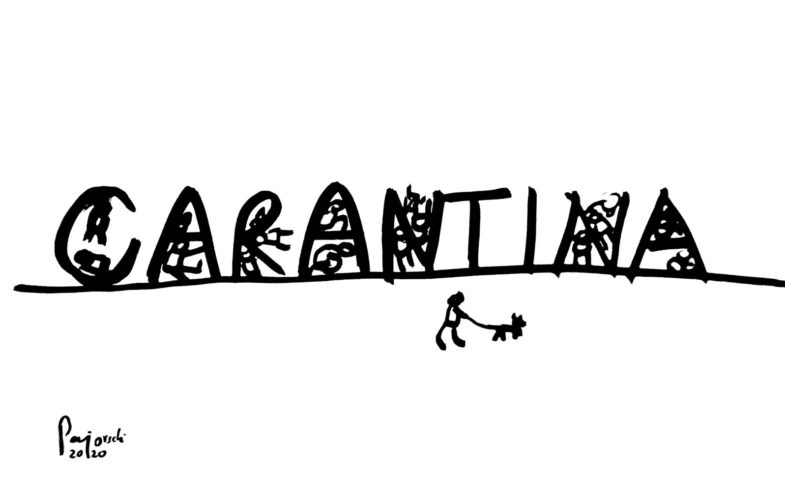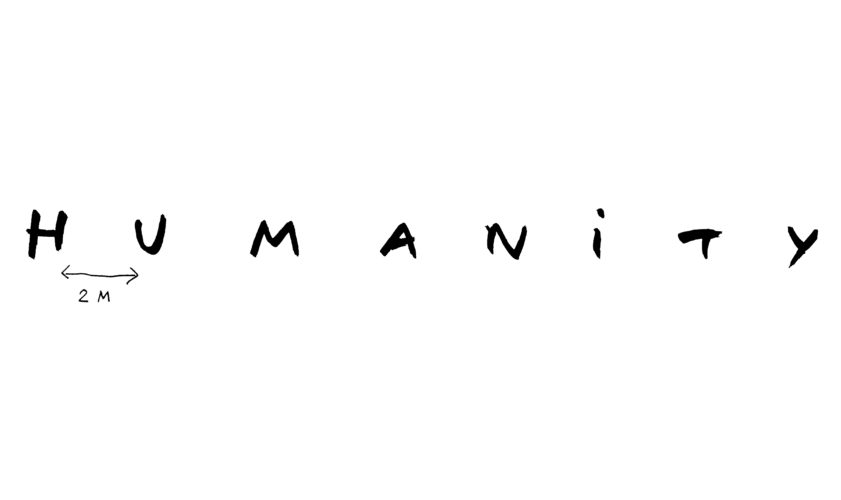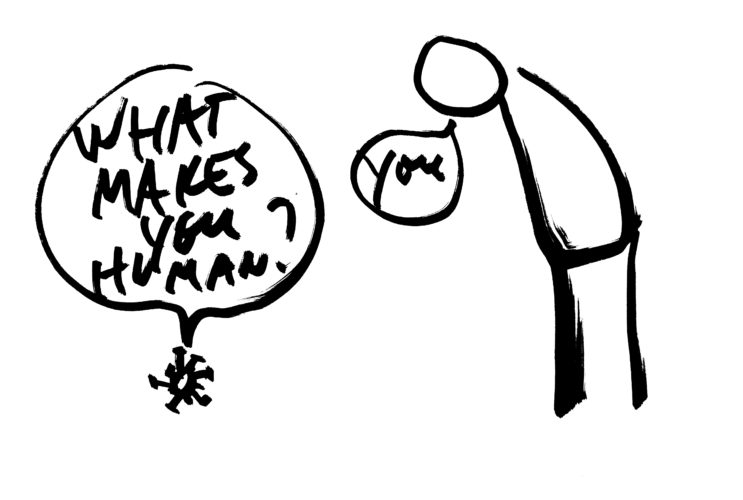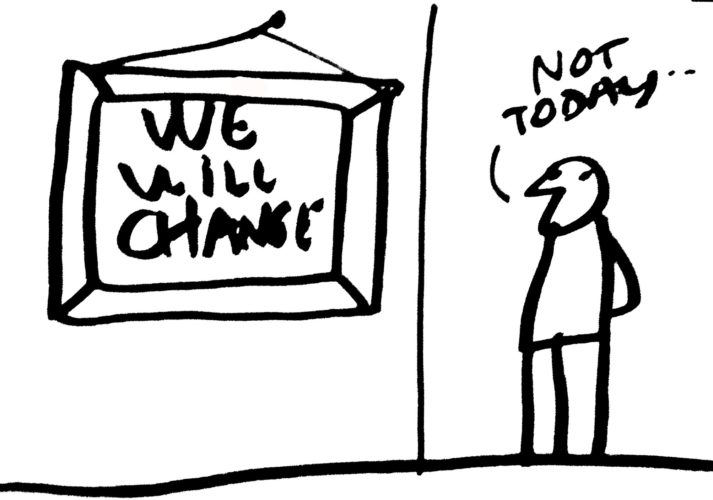I eagerly met my contemporary art seminar’s challenge of studying a Romanian artist. I chose to have a chat with Dan Perjovschi because I admire both the content and the form of his works, because he is an artist that gets close to his audience and produces a living, breathing art, at once satirical and profound. Instead of a standard essay, I chose the format of an interview, because, unlike with artists who are no longer alive and with whom we have no choice but to study their work and life and quote various art critics, with living artists you can actually enter a dialogue, you can understand their first-hand accounts and can problematize the educational, cultural, and socio-political reality that influences our artistic development.
Thank you for agreeing to speak with me in these tough times – for everybody, but especially for the art world. The questions pertain to a number of topics. Some continue in the line of other interviews or discussion that I have studied but found no answer to, others pertain to your past and present connections to the Timișoara art scene, while others are about your methods and tools. At the end I ask for some pieces of advice for young artists in the context of the current crisis.
Many young people, even in art schools, do not know you. Who is Dan Perjovschi? How would you define yourself in one word or drawing? Do you have a cartoon that represents you as a person, husband, artist, or activist?
Art students, be they in school or university, don’t know many things, many artists, nor many contemporary practices (be it in their city, their Europe, or their global world). It is a general problem of the education system (particularly the Romanian one).
I can’t define myself in a single word. But I define myself through any of my drawings that you can find on the internet, on the walls of a museum, or on the display window of a Red Cross shop. I don’t use the term cartoon for what I draw in newspapers, on arts institution walls, in the public space, or on a Facebook wall. It is a visual statement, an editorial in drawing.
So just choose a drawing at random. It will represent me as a person, husband, artist, citizen.
You had strong ties to Timișoara in the ’90s. You took part in the Zona performance festival, organized by Ms. Ileana Pintilie, and now you are involved in the Art Encounters Biennial, also in Timișoara. What do these two festivals mean to you? How do you see the evolution of the Timișoara art scene today?
I had ties to the city even before that, since the Atelier 35 era, which were organization groups for members of the Visual Artists’ Union (UAP). Timișoara and Oradea (where I was working) were very active. I’m good friends with Sorin Vreme, and, right after the fall of the dictatorship, when I came to Timișoara, it was for the Stare fără titlu festival (organized by Sorin and others). It was at Stare fără titlu and then at the Zona triennial that I did some of my most important performances… Due of the Revolution, Timișoara for me is a mythical city and I have never missed an opportunity to come and organize projects here. Lately I’ve collaborated with Tam-Tam, Balamuc, and other independent institutions and projects: Simultan, MAD, etc. I also became involved in Art Encounters, which is not a festival, but a foundation with a permanent exhibition space that offers scholarships and residencies and that also organizes a biennial. This biennial is the largest and most important international art event in Romania. For a long time, Timișoara had disappeared from the visual arts map. I’m happy to be part of its return to fame.
You used to oppose the National Museum of Contemporary Art in Bucharest (MNAC). Have things changed? How is your current relationship with the MNAC?
I have no relationship with the MNAC. I have never set foot there, I don’t participate in their projects, I have never sold a work to them (in fact they haven’t purchased anything since they were founded, in 2004, which is a national disgrace and further discredits them, if that’s even necessary).
I also broke it off with the ICR (Romanian Cultural Institute) after 2012, when they turned nationalist, and if I ever take part in exhibitions partly financed by the ICR, I pay for my own expenses (and I only participate to support the curator or the project).
I don’t apply to the AFCN (Administration of the National Cultural Fund), I don’t need the Ministry of Culture.
I avoid Romanian state museums. In fact, with small exceptions, I avoid all Romanian state institutions.
And let’s be clear: I don’t oppose the MNAC. I ignore the MNAC, this institution located in the Parliament building, behind a wall and far, far away from citizens, this institution with metal detectors at the entrance, like in an airport, and without income statements on their website… This institution is just not part of my art scene.
I know you’ve had important, beautiful moments throughout your career, like the Venice Biennale of 1999 or the exhibition at MoMa in 2007. Could you tell me about a difficult moment in your career, a moment of searching, of questioning, of indecisiveness? (I don’t mean the start of your career, which was marked by material hardship, as it seems that only spurred your creativity on.)
Other important moments were when I covered my Oradea apartment in paper and drew all over it as a surprise for Lia, that was in 1988, so my first “architecture” drawing, and also when I got Romania tattooed on my shoulder at the Zona festival in 1993.
I had moments of confusion between 1994 and 1998, until what I was doing for my newspaper and what I was doing in art spaces came together into one activity. After 1999 everything went smoothly (with the normal introspection and self-questionings in the career of every artist, regardless of fame or age).
And a brief note: material hardship can make you creative for a while, but if it lasts long enough, creativity just goes to hell. The problem during communism was that we were a closed-off country. We were excluded from international discussions and then the problem during the transition was that we were poor and lacked institutions to support us. We were on our own.
You are one of the most well-known Romanian artists with a performance-based practice after 1990, but the fame and prizes more often came from abroad rather than from Romania. Why do you think it is that in Romania you are valued more as a supporter of civil society?
I mean, what prizes are we talking about? The ones from the UAP don’t matter and are given out at random anyway. I got a prize from Radio România Cultural, which is now, paradoxically, the media outlet closest to the visual arts. I appeared a lot on TV, there are two or three documentaries about me, I always appear in regular or specialized newspapers and magazines: ARTA, IDEA, or Zeppelin. I had a lot of projects in Romania, Târgu Ocna (Cercul de Artă Contemporană), Focșani (UAP galleries), Bucharest (the Sandwich art space or Salonul de Proiecte), in Timișoara (Balamuc), and Iași (Anticamera). I have exhibited in Târgu Mureș, Sfântu Gheorghe, Constanța, Brașov, Alba Iulia, Arad…
At the moment I have an exhibition at White Cuib in Cluj.
I held presentations and discussions about my artistic practice in many places throughout the country, in galleries, high schools, community foundations, Ted talks, and various festivals. Since 2010 I’ve had a huge public mural in Sibiu. It’s free and open 24 hours a day, 7 days a week, and 12 months a year. You can’t avoid them. You have to activley seek not to see me. Or, rather, to be culturally unprepared (like art schools, ha ha).
In Romania I work with alternative, artist-run, or independent spaces, with the National Dance Center (CNDB), that is, with choreographies, as well as with private foundations like Art Encounters. For the first edition of their biennial I drew on the glass façade of Halele Timco, a wide, spectacular surface. And, at the same time, I exhibited a photo in the guardhouse of the Art Museum in the city center, the place that I would draw all over in 1991… isn’t that neat? I exhibit in art museums, but in the guard’s space, not the director’s – ha ha…
Yes, I’m known in civil society because I’ve been part of it since 1990. I greatly admire all civic or activist centers, foundations, associations, and project that have kept Romania within the civilized world. If you come to Sibiu you’ll see scattered throughout the 30 meters of drawings some black ribbons. They contain the names of these foundations and associations which have done great things in Romania. It’s my way of celebrating them 30 years from the Revolution.
So the fact that I’m better-known and recognized outside of Romania is just an impression. In Romania I get precisely the recognition I need, in the independent and critical part of the art scene, the most active, interesting, and valuable part.
From a simple roll of paper, to windows, floors, and entire walls, from an apartment work at the museum in New York to, recently, the online environment, your works could be seen by very many people. What was the most unconventional medium (surface, writing surface) on which your works were displayed and why?
At Palazzo Madama Milano: a glass floor above some Roman ruins. I was allowed to draw on it, but from underneath, under the visitors’ shoes. You realize I had to squeeze in between the ruins and the floors and write backwards, while groups of visitors walked above me… and there were groups of Germans, old people, I was worrying if I move now they’ll die of fright… and also a mine in the Ruhr basin with these giant black, and very abrasive, walls, a metal floor, and six huge rooms… I drew there in chalk for like 3 months… (well, not non-stop). Kokerei Zollverein in Essen, for a more ambitious and critical project curated by Marius Babias, over the course of 3 years, called Essen, Arbeit, Angst (Food, Work, Fear).
And, you won’t believe it, at the Brukenthal Palace in Sibiu, where I painted in fine pencil over the clay-covered walls… so that at first glance the walls seemed bare, but if you got close to just a few centimeters distance you could see the drawings… and so from afar it seemed like people were staring at blank walls. The thing is that, being a clay surface, if you rubbed your hand over you could erase the drawing, and somehow the tension between this fragility and the baroque palace’s solidity lent weight to the exhibition.
Do you prefer simple, self-contained drawings or complex installations (walls)? How do you decide on the composition of your large works: aesthetically or depending on the message? Do you works respect visual conventions, with focus points, or do you draw randomly in space?
I like both. Sometimes I draw on a huge space belonging to some important museum, but what brings me the most joy is to do it in my tiny notebook, on a 10 X 8 cm page: then I draw something that I know is good. I just know… Simply put, I enjoy drawing by drawing the complex installations I make in various art institutions around the world.
On a page I don’t think about anything aesthetic, just how to best situate the idea, in the simplest, most direct manner. On a wall or a space, I direct the composition of the drawings (not just visually but also in terms of ideas, that is, I pay attention to variation, to touching upon all relevant issues, etc.).
The beginning is always random, one drawing here, one there, until I can “control” the entire space. What follows are short working sessions and long sessions of thinking, feedback, and decision-making, what drawing to do next, where, and how big. I make clusters of drawings, I leave empty spaces to give the eye the chance to rest, and I highlight interest points. After the first 3 drawings, each new one changes the overall composition. Generally, my drawn installations have between 50 and 200 drawings.
In 2018 you had around 250 notebooks. How many have piled up in the meantime? Do you also use your phone, tablet, or the internet to mark down or archive your ideas and drawings?
I don’t remember… some were purchased by the museums I had projects with. Generally I had 1-2 project notebooks and around 20 projects a year. Now it happens that I draw between projects or to have two exhibitions in the same notebook. I don’t have a principle anymore. I have a flow. I do use social media. And now, during the pandemic, I exhibit online.
I am still smarter than my phone. That is, I don’t work on my phone or tablet. I still draw on paper, photograph it, edit the image (even if it’s black-and-white), and then send it in. I need all that time to think and rethink. Not all my drawings are good. Or not all represent the synthesis I’m after. In the time it takes me to scan and edit something I can come up with a new idea or two. Sometimes the first version is not the best. That’s why I deliberately avoid having a minimum response time. I want time.
Yes, I have folders with drawings grouped by theme. I have around 300 which make up the “core” of my art, into and out of which come drawings or visual ideas, either to be dated or because I found something more fitting to that theme. My repertoire contains drawings from 1993 to yesterday.
Your Facebook page is a kind of notice board. Why did you choose Facebook as a performance space? What do you think of other virtual socializing spaces like Instagram etc.?
I find Facebook more complex, as it has text and image, so you have some room to work in. Twitter is too “short” and too celebrity-based and Instagram is just photos…
Even though drawing is humanity’s most archaic practice and all I do I do by hand, old school, I’m fascinated by new media and social media. I think they offer some great tools to the individual and the collective. You know, when I used to do video, it cost 1000 German Marks per montage hour ha ha… But I wouldn’t call performance what I do on Facebook… my wall drawings are performative. Because, even if you don’t see me drawing it, you can imagine the act of drawing, the speed, the path of the marker on the wall, the balancing of the body on the ladder, etc. Sometimes it really is a performance, as I can’t be isolated from the flow of visitors, and then I draw live… I avoid this because with me it’s not the spectacle that’s interesting, but the idea.
For me Facebook is art in the public space, as well as conversation, debate, polemic, and a common space to share ideas or proposals pertaining to society, art, activism, the community… it’s a space of engagement.
I don’t post cats.
If it were possible, what (physical) wall in the world would you like to draw on?
I have no such obsessions. For me any wall is good. But I will tell you what wall I will never draw on: on the one closing off the Palace of Parliament (and the Museum of Contemporary Art) from the citizens. That one needs demolishing.
Through your drawings you draw the viewer’s attention to “the hot spot” where they should look. At a first glance you say it with humor, but, on closer inspection, also with depth and empathy. Do you think your art can change the world around?
Yes. It already has. Otherwise my drawings wouldn’t be on protest signs, on the covers of PhD theses, or in the National Technical Library in Prague. They don’t bring radical interpretations, nor does it upend the order of things, but instead shows it with more depth, makes it more human. The viewer “knows” the topic, but when they also “see” it, they understand it better. It sounds nice in English, because I see refers both to sight and to understanding. But I’m not naïve. I’m not there, on the political front line, to pass laws and make decisions that immediately impact people’s lives. I’m neither Médecins sans Frontieres to save lives in the midst of a catastrophe, nor am I a founder of Dăruiește viața/Give life to build a hospital for children with cancer. I make the drawing on the t-shirt sold to help fund that hospital, I design, for free, the logo for those who save lives, and I critique the politician’s decision (if it’s bad) and make my critique public. I’m a commentator. I’m not an activist artist. Nor am I a political one. I have my agenda and help out activists. My art is a flow… it is not one single work that can be printed on a stamp or to be made into world heritage like Brâncuși’s Column (which then breeds endless references), I don’t have one single Work… I have a stream of opinions and visual comments on the world I navigate through.
You choose topics that “hurt,” topics with which viewers identify. When did you feel that your interest moved from the topic of art to that of society? How do you convince people that what you do is also art, and not just funny political commentary, for instance?
Ever since my years at (that boring) university, I’ve been interested in “art outside art” and have tried to be active on various platforms (Sci-Fi or cartoons). The UAP’s galleries never appealed to me. After the revolution, my “museum” was the newspaper, and my gallery had 16 or 24 pages. Through the press I got to subjects that hurt because, in that frenzy of printing without censorship, everything hurt. That’s why my installations tackle social, cultural, or political topics, basically the weekly section of Revista 22. I’m part of the first wave of civil society, when the first NGOs appeared in Romania. And it seems I’m part of the second and third wave too. For me art is either society or nothing at all. A long time I struggled to educate and explain that what I was doing was art and that my drawings aren’t sketches or scribbles and are as valid as a bronze equestrian statue and in fact more so. And smarter too. Around 1996 an American curator told me that newspaper drawings are art in public space and I, who had never heard of these categories, was flabbergasted. I then fused together what I was doing for prestige, in the galleries, and what I was doing for work, at the newspaper. Since then my practice has been one of infiltration: into gallery walls, book covers, museum windows, post office buildings, theater walls, post cards, trams, magazines, t-shirts, signs, Facebook pages… These days I’m infiltrating the internet. Now, after hundreds of exhibitions in great museums and small alternative spaces throughout the world, I’m feeling relaxed.
You are relatively close to young artists, perhaps even more so than to those from around your generation. What advice would you give us? What should we do to keep our faith in ourselves and in our art alive? How can a young artist build their inner system for endurance in an economically and socially precarious world?
It sucks to give advice, because experiences and contexts are unrepeatable. Yes, I’m closer to young artists because they seem more alive.
Art needs endurance, it has to be thought of not in terms of weeks, not even years, but decades. Do you see yourself doing this in 10-50 years? Then keep at it. There are no shortcuts.
For me the principles of an artistic life are simple:
a) know the map – what galleries, non-profit spaces, curators, projects, and museums do you have in your area? How about in other cities? On a national level? On a European or world level?
b) know what people were doing here and abroad in the ’60s, ’70s, ’80s, and yesterday.
c) what are the trends and what scholarships, residencies, master’s and post-master’s programs are on offer in Europe, North America, and the world?
d) what kind of art do you like? Who is making it and where? How can you contact the person?
After you’ve placed yourself on this map very precisely, see how you can move around in it.
e) what kind of conceptual or technical supplies do you need to head out?
f) you’re young, you have nothing to lose, try everything – performance, living room galleries, online projects, the public space, social interventions, art and activism, art and society, art and politics, land art, détournement, etc.
g) it’s harder when you’re alone. Get together.
h) before all these points, you need to work, to have something to show for yourself, not the production itself but the way you learn. Learn from what you do and how it is received and judged. What others say matters, but only about 20%. Build yourself a group on which you can count, not to praise you but to understand you.
How do you live as an artist? I’ve had a steady job for 35 years, and have done many other jobs on the side. If you can’t sell, what do you do (yes, do sell, don’t be afraid, it’s your work, and yes, you need to know your “price” relative to what you do, how much you’ve produced, and how others price themselves: find your own place)? So, if painting or happenings don’t bring you money, draw posters, lead workshops with kids, design a logo, paint a wall, etc. Be resourceful. It doesn’t have to be just the art world. Do anything to be able to do what you love. Do what you can with what you have.
What are your resources? Youth (that is, energy), a peer group? Share things with them. Maybe you saw a cool show or a good album. Show it to them, talk to them about it, make a presentation for those who haven’t seen it. Maybe you have a house in the countryside. Organize a camp. Maybe you have an empty-ish room. Turn it into a gallery. It’s tougher for your colleague in New York. The rent there is at least 1500 dollars. There are no public funds there… It’s also tough for your colleague in Berlin, there are hundreds of thousands of artists there… How are you supposed to get yourself noticed?
What do you think is most important for a young artist – talent, networking, entrepreneurial spirit, education? What is the golden combination to succeed on the art market?
All of the above. To which I would add honesty and coherence.
You have a whole world before you. If you don’t like what we have now, change it!
The interview was conducted between April 3 and May 22, 2020.
Translated by Rareș Grozea
POSTED BY
Camelia Popescu
A creative spirit in an engineered structured mind, Camelia trained as an engineer, but has evolved professionally in the field of culture and adult education. She is the co-author of the volume “Fa...
www.cameliapopescu.ro




Comments are closed here.